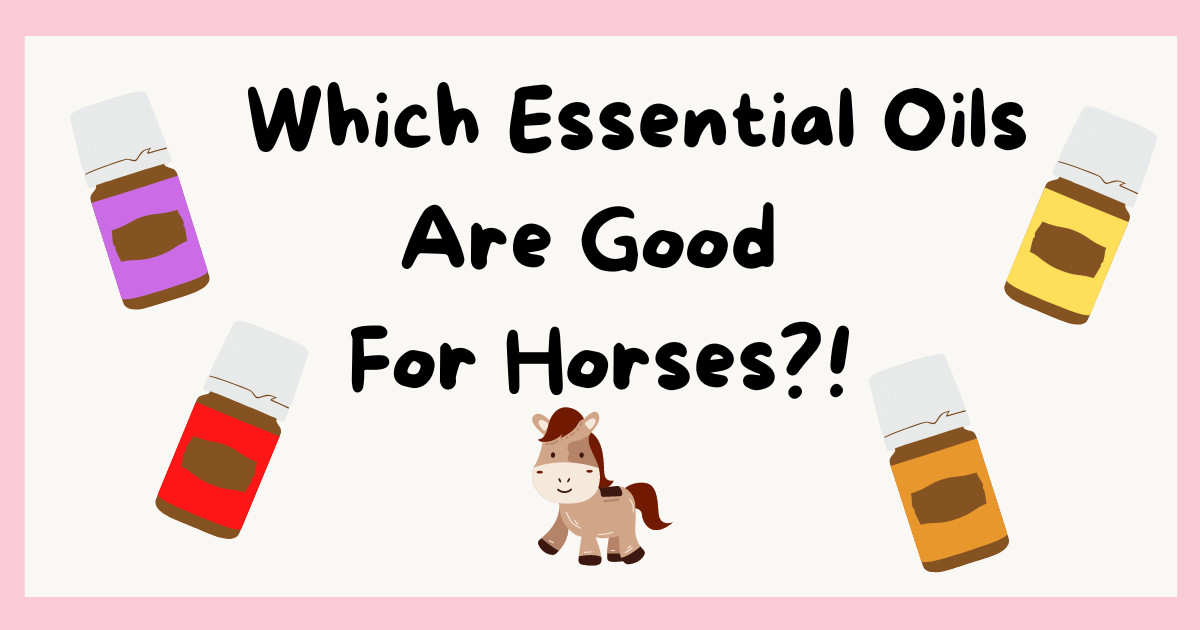
In the realm of natural remedies for horses, essential oils stand out as a versatile and effective option. Derived from plants, these oils offer a holistic approach to equine wellness, aiding in everything from relaxation to skin health. Understanding how to properly use essential oils with your horse is key to their safe and beneficial application.
What Are Essential Oils?
Essential oils are highly concentrated plant extracts. These oils capture the plant's scent and flavor, or "essence," hence the name. Each oil carries the distinctive fragrance and properties of the plant it is derived from.
In plants, essential oils serve various purposes, primarily acting as the plant's defense mechanism against predators, pests, and environmental threats. They also play a role in plant pollination, attracting beneficial insects while repelling harmful ones. Additionally, essential oils can help heal wounds and protect the plant from infections.
How We Benefit:
When we use essential oils, we harness these natural properties for our own well-being. Each essential oil contains a unique combination of compounds that can have wellness effects on the body and mind. For example, lavender essential oil is known for its calming and relaxing properties, while eucalyptus oil is prized for its ability to support respiratory health.
Where Do They Come From?
Essential oils are extracted from various parts of plants, including flowers, leaves, stems, bark, and roots. The extraction process involves steam distillation, cold pressing, or solvent extraction, depending on the plant and its properties.
Three Ways to Use Essential Oils on Horses
- Inhalation: This is the easiest method and the best one to start with and simply means inhaling the aroma of the essential oil.
- Topical Application: Essential oils can be applied topically to your horse. Best practice, especially if you are new to essential oils, is to dilute the essential oils in a carrier oil for application.
- Supplement: Yes! You can give essential oils as a supplement to your horse. You need to read your labels and only use essential oils labeled for ingestion.
Let's dive more into each method with practical ways to incorporate it into your barn life:
Inhalation
Inhalation is a simple and effective way to introduce essential oils to your horse. This method involves allowing your horse to inhale the aroma of the oils, which can have a variety of benefits. You can do this by simply opening the bottle of essential oil near your horse, as their sense of smell is much greater than ours.
Alternatively, you can drop a few drops of oil onto your palms, rub them together, and offer them for your horse to smell. This allows both you and your horse to enjoy the aroma, as you are both part of the partnership.
Another option is to wear diffuser jewelry, which allows you to carry the scent of the oils with you. This way, you can become a walking diffuser for your horse. You can also make your own perfume with essential oils, creating a personalized scent that can benefit both you and your horse. For a quick guide to making homemade perfume with essential oils, click HERE.
If you have electricity available and a more closed barn environment, you can use a diffuser to disperse the oils into the air. My favorite type of diffuser is ultrasonic, which uses water and ultrasonic vibrations to create a fine mist of oil particles. This method is gentle and safe for horses. Check out my favorite diffuser HERE.
If you don't have electricity or a diffuser, you can use wooden clothespins, cotton balls, or even cork stickers available on Amazon to absorb the oils and release the scent gradually.
Topical Application
Topical application of essential oils involves diluting the oils in a carrier oil and applying them directly to your horse's skin. This method is great for targeting specific areas of concern, such as muscle soreness or skin issues.
Essential oils can penetrate the skin and enter the bloodstream, providing localized and sometimes systemic effects. When applying essential oils topically, it's important to dilute them properly to avoid skin irritation.
In general, a 5-10% dilution is adequate for most horses when using essential oils topically. If you and your horse are new to essential oils or trying a new oil, it's wise to start with a lower dilution and observe your horse for any signs of sensitivity. Factors such as your horse's age, size, weight, health, and general sensitivities can all impact the appropriate dilution. For a helpful guide on dilution, you can grab my easy guide HERE.
If you experience a reaction, simply add more carrier oil to further dilute the essential oil and allow your horses body to process it at a slower rate.
My favorite carrier oils include fractionated coconut oil, which is a lightweight, odorless oil that absorbs quickly into the skin.
Jojoba oil is another great option, closely resembling the skin's natural oils and providing excellent moisturization.
Coconut oil, while solid at room temperature, melts easily on contact with the skin, making it a versatile carrier oil.
You can use any carrier oil you prefer, and other products like natural soap, witch hazel, vodka, and aloe vera gel or juice can also be used as carriers. For more information on diluting essential oils for horses with carrier oils, check out my dedicated blog HERE.
Supplement:
Using essential oils as a supplement involves adding them to your horse's feed or dropping them (diluted) into the lower lip. This is an advanced method that allows for internal absorption of the oils, providing systemic benefits. However, it's crucial to use caution when administering essential oils internally, as not all oils are safe for ingestion.
When it comes to using essential oils as supplements, it's crucial to read your labels and only use oils labeled for ingestion, such as my company's Vitality™ line, which you can check out HERE.
Ingesting essential oils can be a controversial topic, but it's worth noting that you and your horse may already be consuming essential oils in the products you buy or have used in the past. Many equine feeds on the market contain essential oils as natural preservatives, and they are also commonly found in human food products.
If you're unsure about ingesting essential oils, there are plenty of other ways to use them, but I encourage you to delve deeper into the topic and not just believe the hype. Make an informed decision based on facts and research.
It's also worth mentioning that many essential oils are listed on the Generally Recognized as Safe (GRAS) list. This list is maintained by the U.S. Food and Drug Administration (FDA) and includes substances that are considered safe for consumption based on available scientific evidence and expert consensus. Being on the GRAS list provides reassurance regarding the safety of ingesting these essential oils when used appropriately.
Additional Application Methods
In addition to inhalation and topical application, there are several other creative ways to incorporate essential oils into your horse's wellness routine.
1. Shampoos and Bath Products: Adding essential oils to horse shampoos or bath products can enhance their cleansing properties and provide a relaxing experience for your horse. For a DIY horse shampoo, mix a few drops of essential oil (such as lavender or chamomile) into the amount you're going to use of a natural, unscented shampoo base. This can help soothe your horse's skin and promote a shiny coat.
2. Sprays: Creating a spray with essential oils is a convenient way to apply them to your horse. Mix about 10-20 drops of essential oil to 2 ounces of water in a spray bottle and shake well before use. You can use this spray to freshen up your horse's stall, bedding, grooming area, or even spray in your horse trailer before travel. Peppermint and lemon essential oils are great for creating an uplifting spray, while lavender and Roman chamomile oils can be used for a relaxing scent.
3. Liniments: Essential oils can be added to liniments to create a soothing muscle rub for your horse. Mix a few drops of essential oil with a natural liniment base (such as arnica or witch hazel) and apply it to your horse's muscles after a workout or strenuous activity. Peppermint and wintergreen essential oils are popular choices for their cooling effect, while lavender and chamomile can help relax muscles. For an easy peppermint brace perfect after a summer ride-click HERE.
4. Grooming Products: Incorporating essential oils into grooming products such as mane and tail detanglers, hoof conditioners, or natural fly repellents can provide added benefits. For example, adding lavender to a mane and tail spray can provide a relaxing aroma and skin and coat benefits. For more help in using essential oils in your grooming routine, click HERE!
When using essential oils in these additional ways, always start with a small amount and monitor your horse for any signs of sensitivity or irritation. It's also important to use high-quality, pure essential oils to ensure effectiveness and safety.
Essential oils can also react with petrochemicals, so it's important to only add them to products with natural ingredients. If your goal, like mine, is to transition away from toxic chemicals and toward a natural approach to horse care, you're not only benefiting your horse but also yourself and the planet!
Safety Precautions
While essential oils can offer numerous benefits for horses, it's important to use them safely and responsibly. Here are some key safety precautions to keep in mind:
Quality Matters:
One of the most critical factors in using essential oils safely is quality. Not all essential oils are created equal, and some may contain synthetic additives or impurities. Read your labels and look for essential oils that are 100% pure.
Regulation of essential oils falls under the U.S. Food and Drug Administration (FDA) specifically in the cosmetic category. There are many 'trade secret' loopholes which means that while an essential oil may be labeled as "100% pure," it may still contain synthetic additives or be adulterated in some way. This is why it's crucial to choose a reputable company that prioritizes quality and transparency.
Some companies may use loopholes in labeling regulations to list their products as "natural" or "pure" while still containing synthetic ingredients. It's essential to do your research and choose a company that is transparent about their sourcing and production practices.
I personally use oils from Young Living™, which offers a Seed to Seal®guarantee. This means that from the planting of the seed to the sealing of the bottle, every step of the production process is carefully controlled to ensure the highest quality. I've even had the opportunity to visit their farms and witness the planting and harvesting process firsthand, giving me confidence in the purity and potency of their oils.
Dilution:
Essential oils are highly concentrated, so it's best to dilute them before use. This practice helps reduce the risk of skin irritation and sensitization. Since these oils are absorbed and processed quickly by the body, it's advisable to apply a small amount of diluted oil more frequently than a large amount all at once. This approach allows you to observe the effects and fine-tune your usage accordingly.
Storage Tips:
Proper storage is essential to maintain the potency and effectiveness of essential oils. Store them in a cool, dark place away from direct sunlight and heat sources. Sunlight and heat can cause the oils to degrade and lose their wellness properties.
Additionally, ensure that the bottles are tightly sealed to prevent oxidation. Contrary to popular belief, essential oils do have a shelf life, and storing them correctly can help prolong their efficacy. For more tips on essential oil storage and usage, check out my blog HERE!
Essential oils can offer a natural and holistic approach to promoting the wellness of your horse. From aiding relaxation to supporting skin health, these oils can be a valuable addition to your natural horse care routine. By understanding the various ways to use essential oils, such as inhalation, topical application, and supplementation, you can safely and effectively incorporate them into your barn life.
Remember to always use high-quality, pure essential oils, and to dilute them properly before use.
If you're ready to dive deeper into the world of essential oils and learn how to use them safely and effectively with your horse, consider enrolling in my course,"Oily Horse Intro." This course is designed to help you start using essential oils with your horse with confidence and ease, without feeling overwhelmed.
You'll learn about essential oils, their benefits, and practical ways to incorporate them into your horse's routine. Join me on this journey to enhance your horse's well-being naturally with the power of essential oils. Sign up now and embark on a new, holistic approach to horse care! Click HERE!











0 Comments